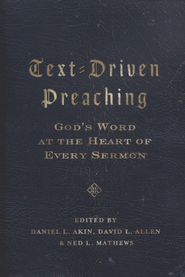
This book review of Akin, Allen, and Mathew’s Text-Driven Preaching was written as part of Pastor Lane’s doctoral course work, and as such, it is written in a more formal, academic tone than the rest of this blog’s posts. Still, we hope the audience will find these academic book reviews useful, which is why we have published them for your reference.
Text-Driven Preaching masters the art of expository preaching from every angle, just as the title states. The book’s format hosts a familiar design with other preaching book covering the preacher, preparation, and preaching. The authors of each chapter represent a wide range of experience and perspective in writing. This book presents a distinct richness in covering the whole topic of preaching, from historical background to key concepts to modern practices.

The first section addresses “The Preacher” and begins with the historical roots of rhetoric and how it has shaped preaching. This chapter introduces the three famous rhetoric means of persuasion in Aristotle’s Art of Rhetoric: ethos, logos, and pathos. The author defines each of these elements, demonstrates their importance, and shows their inter-connected relationship for the preacher with contemporary relevance. The historical overview of text-driven preaching traces a comprehensive line of model preachers and gives the reader an excellent reference source for study. The third chapter introduces that the secret to effective preaching that must begin in preparation. The reader is challenged to approach sermon preparation with complete dependence on Holy Spirit in study and meditation. A diversity of perspectives is given to illustrate practical dependence upon and surrender to Holy Spirit in preparation. Deeper issues of character and holiness are explored while presenting a compelling argument that the text is the preacher’s central content.
The second section addresses “The Preparation.” I found this section to be a wealth of information and a very strong resource guide to encourage, remind, and refresh in practices of sermon preparation. The first chapter of this section sets forth a foundation for text-driven preaching by saying, “Not only should sermons be based on Scripture; they also should actually expound the meaning of that text.” It goes on to explain “text-driven preaching stays true to the substance of the text, the structure of the text, and the spirit of the text.” I found these two sentences very clarifying in describing text-driven preaching. The real value of this section was the extensive explanation given in the “how-to” of preparation and the excellent questions for a proper, comprehensive analysis of the text. The introduction to biblical genres and biblical theology also lead the reader to fully master the text in study and preparation.
The third section addresses “The Preaching.” The introduction to communication theories is helpful in considering best ways to maximize the presentation of the message. The chapter on delivery was helpful as it addressed the relationship of pathos and logos and gave further clarification and understanding. The final chapter on application presents excellent parameters for knowing how and understanding why faithful application is so important in sermon delivery.
I thoroughly enjoyed and gleaned from this book in format and content. It serves as an excellent comprehensive resource.
More book reviews by Pastor Lane